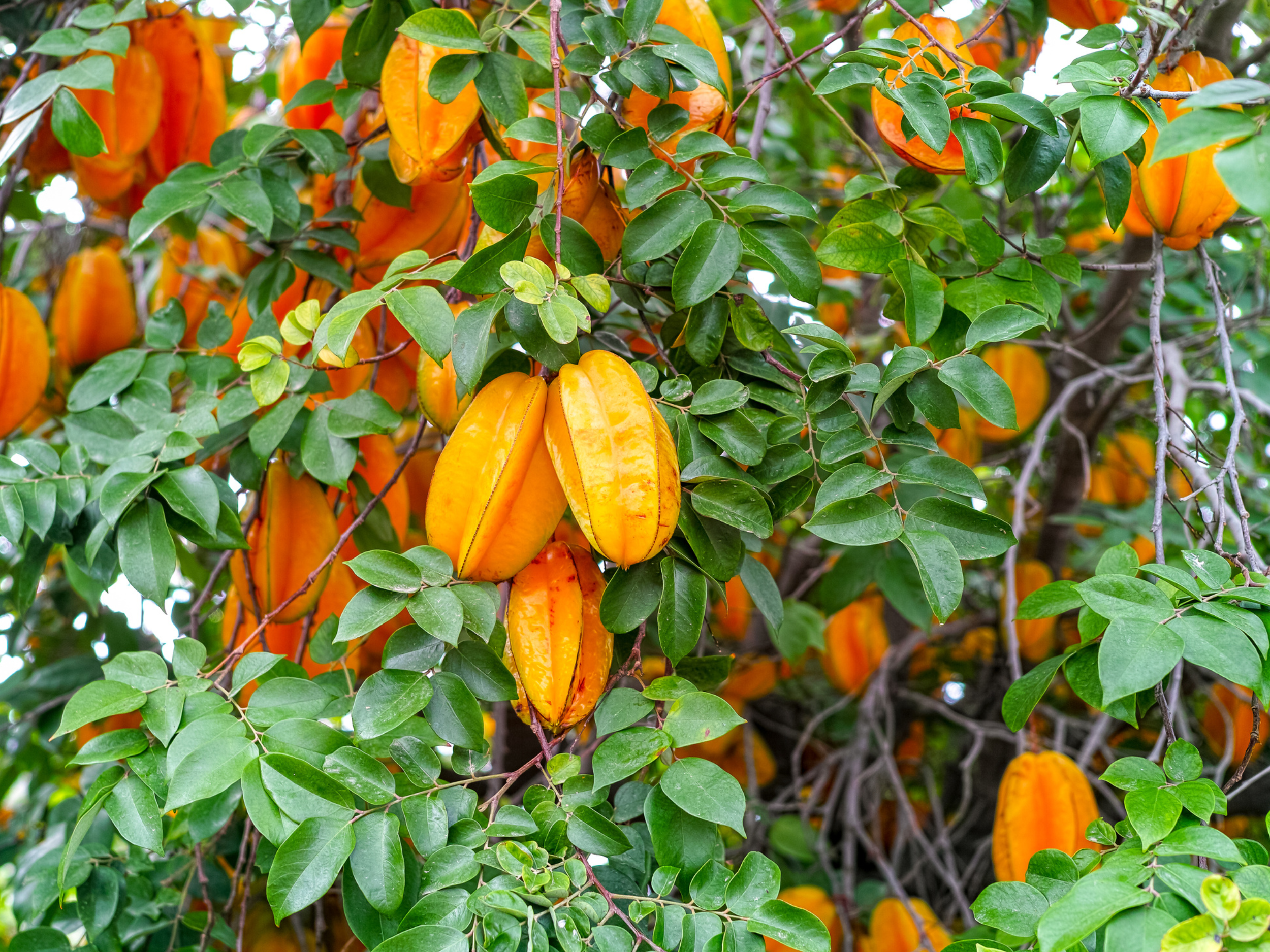
Plants for food forests in Florida
What can we say about mango? It is probably the most delicious fruit on the planet and comes in hundreds of varieties, ranging in flavor from coconut cream or piña colada, to lemon zest or even spicy turpentine. Dwarf varieties keep tree size manageable, and even a small tree can produce more fruit than you can eat. They are fast growers. Trees can be purchased at a manageable size (13 gallon pot) that will likely fruit within two years. Mangos come in early and late varieties, and planting one of each guarantees fruit all summer long. One word of caution: Mangos do not tolerate frost, so in Florida it is best to plant south of Lake Okeechobee or in areas along the coast that are moderated by ocean breezes.
˜
Sapodilla is an ideal tree here in South Florida. For starters, it can fruit up to three times a year, and has no real known pests. The blossoms are very fragrant, reminding some of creme brulee. The fruit has a unique flavor profile with hints of cinnamon, brown sugar, and pear. Like mangos, sapodillas need full sun to produce maximum fruit, so it would be best to treat them as a canopy tree. This is a fruit you will not find at the grocery store making it is a wonderful addition to your backyard food forest.
Avocado is just so delicious, nutritious, and versatile in the kitchen that every food forest where they can be grown should have some. Here in Florida, you can grow multiple varieties that fruit in fall, winter and summer. Avocado trees need full sun to produce maximum fruit, and the fruit does not ripen on the tree. This makes it easy to pick as you need and stretch the harvest. Avocados do not like areas that are too wet, so take care to keep them separated from water loving plants like bananas.
Papaya is probably the perfect inter-canopy tree for your Florida food forest. They are one of the fastest growing trees around, producing fruit from seed in under a year. You can purchase papayas from the garden section at your local big box store, often for under $20, and enjoy fruit from your backyard within six or seven months. Once papayas start to fruit, they just keep going. Two or three healthy papaya trees can produce more fruit than a typical family can consume, and their space requirement is quite small with the canopy spreading only five feet or so. Papayas are delicious when ripe, but can also be shredded and used for salads when green.
Bananas make an ideal herb layer for your food forest. They are fast growing, with “pups” constantly sprouting up to renew the harvested mother plant. Dwarf varieties are available and fit nicely between your fruit trees. Bananas are eaten ripe but can also be cooked and eaten as a delicious starch when green. Make sure to give your banana plants plenty of water and plenty of organic matter, and they will reward you with a steady supply of delicious and nutritious fruit.
Sugar apples are a wonderful addition to your food forest. They are beautiful and almost delicate looking trees that grow very quickly and will likely fruit the year they are planted. They make perfect understory trees or they can act as canopy trees, allowing dappled sunlight to filter down to trees such as starfruit, jaboticaba or citrus. The fruit ripens in the summer or early fall and is truly delicious. This is another fruit that you will not be able to find in the supermarket as it must ripen on the tree and is very fragile once ripe. One thing to note is that the leaves will blacken and even fall off in the winter time but not to worry, fresh new shoots will quickly appear.
Starfruit is a true champion of the food forest. It will bloom twice a year and usually produces massive amounts of fruit. Starfruit trees love sun but will also do well in partial shade, making them an ideal understory tree. Like sugar apples, they are delicate looking trees, lending a certain grace to the garden. When in bloom, beautiful purple flowers cluster along the branches and quickly transform into the uniquely-shaped fruit. Starfruit are best ripened on the tree, however they will tend to fall if left too long. Enjoy starfruit alone, in salads, or as a sweet accent in cooked dishes.
Although mulberry is actually a tree that can grow quite large, it is best kept short as a bush for two reasons. First, the berries are delicate and must be hand picked. Second, every time you trim a mulberry it triggers the tree to bloom again. Once established, a mulberry can be trimmed and harvested multiple times each year. The berries are delicious, similar to blackberries in flavor but having an almost melt in your mouth quality with none of the annoying seeds.
June plum might be the only tree in your food forest that outpaces papaya. Trim it to keep it short and enjoy fruit during the fall and winter months. Like the sugar apple it may loose its leaves in the winter but they will sprout back in the spring with amazing vigor. The fruit when ripe is delicious with a flavor that is somewhere between pineapple, mango and soursop. It can also be picked and eaten while green for a crisper and tarter result.
Jaboticaba is a fascinating tree in that the fruits actually grow right out of the trunk and branches. It is a slow growing tree with beautiful bark, similar to guava. The fruit is comparable to a grape but with much more depth and aromatic complexity to the flavor. Jaboticabas are one of the few trees that will fruit well in partial sunlight, making them an ideal understory tree for your food forest. Since they are slow growers, jaboticaba trees are relatively expensive. Set aside extra money and buy a mature tree that is already fruited and you will not be disappointed!
Chaya is a plant that most Americans are unfamiliar with, but they should be. Popular in Mexico, chaya is a fast-growing perennial shrub that has more protein, iron and vitamins than spinach. It can be easily grown from cuttings and will quickly reach a full size of ten feet or so. Chaya is reported to have many medicinal properties and has been used for all sorts of ailments in its native region. The leaves contain hydrocyanic glycosides and can be toxic if eaten raw. Fortunately, these compounds break down easily when the leaves are cooked.
Cranberry hibiscus is a perfect bush layer for your food forest. It is a vigorous plant that grows quickly and can be propagated by simply cutting off a section and pushing it into the ground. The beautiful purple leaves can be harvested and eaten raw. They are delicious and make a wonderful addition to salads or smoothies. Their taste is pleasantly tart and slightly citrusy. The purple flowers can be used to make tea with a similar flavor. Top them at a young age and continue to prune them to keep them bushy. This extends their life, ensures tender young leaves, and keeps them from blowing over in a storm.
Is it a bean or is it a bush? Pigeon pea is both! Beans are a wonderful addition to food forests because they fix nitrogen for other plants while they provide food for you. Pigeon peas fulfill this role while growing for up to five years! If left uncut, pigeon peas will grow to resemble a bushy tree about ten feet tall. It is recommended to trim them and keep them short as more of a bush for maximum yield. The peas can be harvested in a young stage and eaten pod and all similar to edamame. Alternatively, when the peas mature they can be removed from the pods and used like beans.
If you live somewhere hot, you should consider planting tindora in your food forest. Tindora is a fast growing vine that produces small cucumber-like fruit all year long. The fruit can be harvested early when it is green and resembles cucumber. At this stage it is crispy and only a little bitter. Great as a snack or used like a cucumber in salads etc. As it ripens, it gets softer, the fruit turns a beautiful orange or red and the flesh gets orange. At this stage it looses it’s bitter quality and mellows to where it is almost sweet. Tindora is commonly cooked in curry dishes in India and elsewhere. If you have a fence or a trellis, plant tindora and enjoy the bounty.
Cassava is an ideal root crop for your food forest. In the grocery store you would find it labeled yucca, although it actually isn’t. Yucca is a different plant entirely and is not cultivated for food. Cassava plants can grow around twenty pounds of “yucca”, so having four or five in your food forest ensures plenty of delicious starch for your table. Plant them in February here in south Florida, and harvest them October - December. Then chop up the plant into ten-inch sections and push them back into the soil about 2-3 inches deep. These cuttings will sprout into new plants that will be ready for harvest in a year.
Ever try to grow spinach in the Florida heat? Enter malabar spinach. Malabar spinach is a tropical spinach that grows as a climbing vine, perfect for working its way up your food forest trees or fences. Malabar spinach tolerates heat but hates cold. Frost will kill it so it really is best to plant it after the last of the serious cold weather is gone if you live in a frost zone. The leaves are delicious with a kind of peppery citrus taste and an interesting crisp but slimy (think okra) texture. You can eat them raw or cooked. Malabar spinach is loaded with nutrients, including antioxidants.
It’s interesting how few people know that sweet potato will not only grow in Florida but will thrive in the heat. Sweet potato is one of those plants in a food forest that can simultaneously act as your root crop, your ground cover, and a vine layer. If weeds are a problem in your food forest, plant sweet potato. In a month or so they will completely cover an area and choke out your troublesome weeds. Plant your sweet potatoes in spring or early summer and in four months you will enjoy your potato crop. In the meantime, the leaves from sweet potatoes are delicious, similar to spinach but milder in flavor.
Every food forest needs some sort of ground cover to control for weeds. Perennial peanut is an excellent choice as it creates dense matts that prevent weed growth, does not grow tall, and produces a beautiful yellow flower. Although a peanut plant, it does not produce a harvestable nut. What it does do, however, is fix nitrogen for all of your other food forest plants. Perennial peanut is a good choice for sunny areas or areas with partial shade. It will not do well in full shade.
Another beautiful ground cover is sunshine mimosa. This is a Florida native that is great at choking out weeds while fixing nitrogen. Like perennial peanut, it stays low so it does not need much in the way of trimming. Also like the peanut, it produces a flower, but sunshine mimosa’s flower is a beautiful pink powder puff. The plant is relatively drought tolerant, making it a great choice for a an established food forest that does not require much water.




















